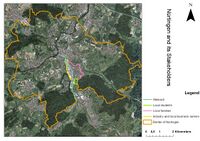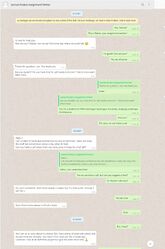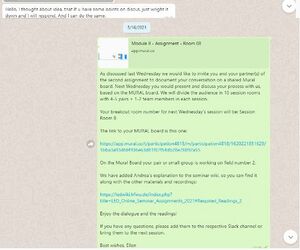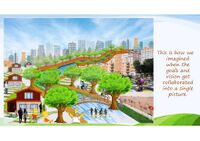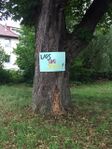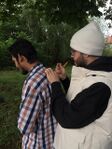LED2LEAP 2021 - Nürtingen Team 1: Difference between revisions
Rehan.wasi (talk | contribs) |
Rehan.wasi (talk | contribs) |
||
| Line 262: | Line 262: | ||
= Phase E: Collaborative Evaluation and Future Agendas = | = Phase E: Collaborative Evaluation and Future Agendas = | ||
== Collaborative Evaluation and Landscape Democracy Reflection == | == Collaborative Evaluation and Landscape Democracy Reflection == | ||
* | *The site context to which we had to collaborate with the community, was taken as a major challenge to us. | ||
*There are many other spaces in the city which are overlooked, and has great potential to bring out the community. | |||
*Rivers are something by which cities were labeled as lucky through which it passes down. Nowadays, it is not celebrated as it used to be. | |||
*Neighbourhood-friendly design aspects play a major role in having a sense of brotherhood when coming outside our homes, and we as designers need to take care of it. | |||
*Everyone is equally responsible as well as entitled to use a landscape environment. Awareness should be spread inside people. | |||
<gallery caption=" " widths="200px" heights="150px" perrow="5"> | <gallery caption=" " widths="200px" heights="150px" perrow="5"> | ||
Revision as of 22:43, 22 July 2021
>>>back to working groups overview
For help with editing this Wiki page use this link.
For assignments and key readings use this link.
| Area | Steinach and surrounding area | |
| Place | Nürtingen | |
| Country | Germany | |
| Topics | Connecting the neighbourhood with the river | |
| Author(s) | Rehan Wasi, Abhishek Vekariya, Mohit Sehrawat | |
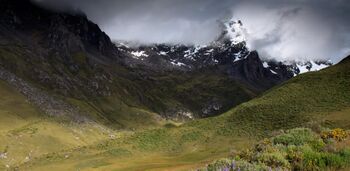
| ||
Landscape Democracy Rationale
Landscape can be seen as a product of society, which is connected to their personal history, according to Berger and Luckmann (1966). "Land", in German, can be seen as a contrast between city and countryside, including meanings such as shape, form, texture, nature, condition and manner. However, in Old High German, the landscape was associated to an object "that has the quality of a larger settlement area in most cases" (Müller, 1977). But a more recent description that fits our current location can best be described as: On's own region or nation is described in terms of its natural and cultural characteristics, so that it becomes socially available as something diametrically opposed to other regions and nations (Lekan and Zeller, 2005).
Location and Scope
- Our focus area is situated at the south-east of Nürtingen. The area surrounds the river Steinach - one of the major tributaries of river Neckar. It has industrial units and settlements are a thread-link to the vicinity of the river.
- The whole stretch of the marked area has different types of communities and stake-holders involved. It gathers people from the neighbourhood, as well as the passerby.
- It is a road which is parallel to the main road. This could help in creating an alternate thoroughfare, which could be much more interesting to step into.
Phase A: Mapping Your Community
Welcome to the Community and their Landscape
The main location is based around the river named Steinach, which is a side river from the Neckar. The Steinach river is currently not in his natural state cause of the densely built environment. So to prevent flooding grass buffers, dams and slopes are currently installed. Except for these grass buffers not much open space can be found here. Most of the parcels connecting the river are privat or used as parking space, missing the opportunity for visitors to walk along the Steinach.
Groups of Actors and Stakeholders in Your Community
- From the spatial character and land use pattern of our study area, we can see different groups of actors and stakeholders. Among the local residents, elderly citizens, kids, land owners and students are considered as important actors of our landscape. As a predominant industrial zone, we have owners, workers and local business persons. We have local clubs and municipality who are more organised actors among the groups. Another significant group we can see in the community are tourists,commuters and investors.
- Children, teenagers and retired and elderly groups are the most visible group in our landscape whereas mid-aged and working class are less visible.
- Depending on the age and social groups, the community has different needs and aspiration.Local residents want to have safety and health as well as interactive spaces.The business group and municipality have aspiration of sustainability and growth from the landscape. Tourists want to have access to attractive spaces with safety and facilities.
Relationships Between Your Actors and Groups
- The stakeholder - those are impacted by the landscape democracy challange and have an role to play have been shown in the power map. Kids and eldery are highly impacted whereas kids have less power.On the other hand,students are more organised group with better power.Local land owners and shop owners,industry owners hold power to influence- making them one of the major stakeholders.Tourists are the group with less power and impact , yet have a significant impact in our study area.Municipality has the most administrative power but likely to be less affected.
Summary of Your Learnings from the Transnational Discussion Panel
When I read about the protest privatization of a public park in Istanbul Turkey in 2013 I was shocked. I never imagined a problem like this would occur in the EU. Because enjoying and experiencing nature is a basic human right, and I never thought it would be possible to take this away from the public. However, this is not the case everywhere because after bringing this up in the discussion panel, other colleges told me they experienced the same situation.
Theory Reflection
The given theory is helpful for a critical start in this project. It gives an overview of the different meanings of the landscape. Which can have a close relationship between science and society. A very interesting statement is for example written in the "Pledge for a transformative science, written by Uwe Schneidewind, Mandy Singer-Brodowski, Karoline Augenstein and Franziska Stelze. Here is described that technological development led to an increased disconnection in society, for example, technological innovations have interfered and are still interfering with the natural and human systems. Resulting in unplanned and often until the point of no return, ecological and social side effects (Beck, 1986). That is why innovation, participation, and balance power are very important in today's society towards the landscape. Which creates the interesting discussion around Landscape democracy.
References
Schneidewind, Uwe et al (2016): Pledge for a Transformative Science - A conceptual framework Kühne, Olaf (2015): Landscape Concepts LED Team (2019):Landscape Education for Democracy
Phase B: Democratic Landscape Analysis and Assessment
Mohit Sehrawat and Ivona Poljak Correspondence
Design as Democracy, chapter Going to the People's Coming, was read by Ivona and I have read literature Community matters. At first of all we got to know each other through email and later on via different social networking sites. At first it felt to be very difficult communicating with Ivona as of our busy schedules but we got time on weekends. The reading part was well discussed within both the topics. Getting to know the community can involve creative scenarios that seem more like play than planning and solved alot of the doubt and question relating to the subjects. It was a wonderful experience to have a tandem partner like Ivona
On photos below you can read in detail the topics we read and discussed about as well as the flow of our conversation.
Abhishek Vekariya and Ahmed Essounni and Tiffany Liu Correspondence Correspondence
Rehan Wasi and Samuel Roskos Correspondence
- REFLECTION
- REFLECTION
- MODE OF INTERACTION
Phase C: Collaborative Visioning and Goal Setting
The Scene in Your Story of Visioning
- The periphery area of the River Steinach in Nürtingen was chosen. It is near to the residential settlements and also to the industrial area. The main issue lies in the connection between the neighborhood and the river. The challenges shown in the figure below illustrate these selected problems.
- Before coming to that, our problem statement was defined as the absence of community spaces for people to gather around and have a place to spend their leisure time. The lack of open spaces nearby, and the accessibility to the river are one of the major concerns related to the problem.
The Actors in Your Story of Visioning
- There were different actors involved, which includes teenagers, children, young families, workers, elders, fishermen, and farmers. Also, local businesses, government institutions, and the municipality council of Nürtingen city are a part of it. The animals are also involved because they live in it.
The Story of Visioning
- The individuals who were working upon it were given a set of tasks to write down the goals separately. Later, similar goals were clubbed together. Now the decision is being made by vote. Each one had 5 votes and could be used as per own wish. Goals were selected on that basis.
- A vision was created: Recreation of humans, plants, and animals across the river Steinach.
- Goals were shortlisted like introducing native species and green buffer in the area to help the biodiversity. Other goals included: Providing spaces to increase the number of activities in parts of different areas, to have steps and spaces to sit closer to the water in Steinach, change of slope gradient from the road to the river so the river is visible from higher ground.
- In accordance with it, the Action Plan was developed.
Reflect on Your Story of Visioning
While formulating goals, we must invite all the opinions and suggestions from the individual member of the team and then choosing the main goal as a collective thinking. The characteristics for a good effective vision : 1. Imaginable 2. Desirable 3. Feasible 4. Focused 5. Flexible 6. Communicable
Phase D: Collaborative Design, Transformation and Planning
Your Prototyping Action
- Firstly, the site was chosen where the activity had to be performed. It is a 3-way road connection in the neighborhood.
- The problem statement was taken into consideration, and the involved community was marked.
- The survey was done in accordance with what the community needs or requires of the choices given.
- Some important questionnaires were prepared for the community, but results were expected to be less likely, in terms of an answer.
- The potential areas were identified on the site, to help in expanding the vicinity and the surrounding of the neighborhood.
- Materials like milk cartons and plastic bottles were collected from the dormitory, and were transformed into games.
- A board was developed which said, "Let us play" in the German language. This was hung on a tree, and was just an invitation to the people on the site.
- Gradually, we started playing ourselves, and asked people randomly, if they wanted to play.
- A few people came by themselves after seeing the activity on the ground.
- They took part, and eventually, the crowd got gathered.
- We invested 2 euros in buying chocolates for people who won the challenge.
- After this, they became friendly, and answered the questions about the river and the neighborhood.
- For more, kindly watch the video on this link :- https://youtu.be/PME_iKDbVLI
The Evolution of Your Prototyping Action
- There were a few things that were in our mind before going in for action on site.
- We wanted people to interact with us, and have a free mind.
- We had thought that if people get comfortable with us, then they will give us time and would certainly take part in our session.
The Plan Behind Your Prototyping Action
- The plan was to interact with the people in a fun way.
- We wanted to extract the child inside them, and in exchange make them feel good.
- The idea was also to use any material, which can easily be recycled or reused, and does not cost a lot of money to build.
The Realization of Your Prototyping Action
- The action was very well taken by the community members. The results were not expected like this, but there was a time when 3 people seemed to be quite less for managing the activity of the site. The number of people interested in playing the games increased at a pace that was not contemplated. The whole scenario changed in only some time, with the use of plastic bottles, milk cartons, a football, and cardboard. We had the happiest moments, and people were curious to help with feedback, all by themselves.
Reflect on Your Prototyping Action
- It was a beautiful experience to interact with the community.
- We did not have feedback from everyone, but most of them were glad that they came to us for some time.
- We as a team was satisfied after the event. It felt like giving a bit of happiness through us.
- Staying there for some time gave us the knowledge that the site has great potential.
- True sense of community belongingness has to be brought back to the community, and we perceived it.
Phase E: Collaborative Evaluation and Future Agendas
Collaborative Evaluation and Landscape Democracy Reflection
- The site context to which we had to collaborate with the community, was taken as a major challenge to us.
- There are many other spaces in the city which are overlooked, and has great potential to bring out the community.
- Rivers are something by which cities were labeled as lucky through which it passes down. Nowadays, it is not celebrated as it used to be.
- Neighbourhood-friendly design aspects play a major role in having a sense of brotherhood when coming outside our homes, and we as designers need to take care of it.
- Everyone is equally responsible as well as entitled to use a landscape environment. Awareness should be spread inside people.
The Actors in your Collaborative Evaluation
- insert text here
Reflection on the Online Seminar
- insert text here
Reflection on the Living Lab Process
- insert text here
Your Living Lab Code of Conduct
- insert text here
Process Reflection
- insert text here

